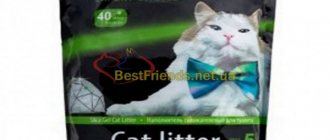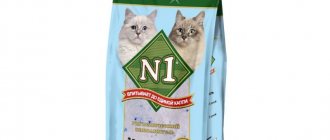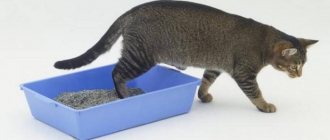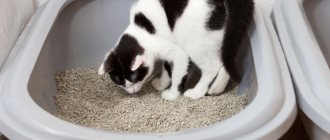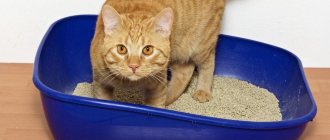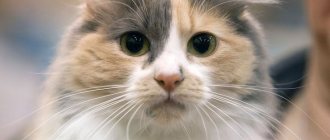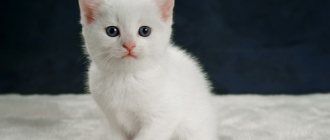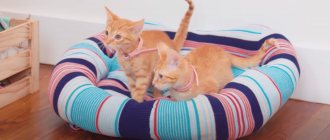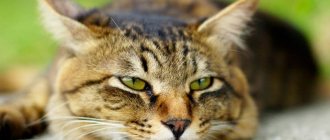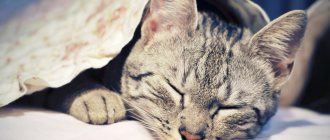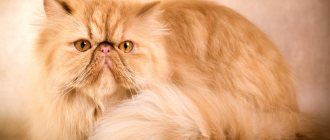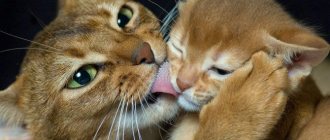For owners who have decided to have a cat in an apartment, the question of choice is important:
- cat food
- litter for the cat litter box so that the house is clean, free of foreign odors and the animal likes it.
Cat litter is a necessary part of the life of domestic cats. The main task of the product is to quickly and effectively absorb excess moisture and unpleasant odors, so they are made from safe absorbent materials.
In addition, they should be simple and convenient for daily use.
Types of cat litters
Fillers for trays are divided according to their mode of action, composition and appearance. Based on their mode of action, they are divided into two groups: clumping and absorbent.
Clumping
The products are made from minerals and finely dispersed bentonite clay, which when moistened turns into dense clumps and is easily removed with a spatula or scoop. After removing the used material, a fresh portion of filler is added to the tray.
For economical use, it is recommended to pour the clumping composition in a thick layer of 10–12 cm. A complete replacement of the material is carried out every 5–7 days. This type is designed for various cat breeds.
It is not recommended to use such formulations for small kittens that taste unfamiliar objects. The filler can swell on the wall of the stomach, causing pain or death.
In addition, a thin layer of hygienic filling can get wet, sticking to the fur and paws of the animal. Such materials are more expensive compared to absorbent compounds.
Absorbent
Fillers belonging to this group are made on the basis of clay obtained by high-temperature drying and pressing. They have exceptional absorbent properties. Clay granules retain moisture without changing their structure.
To maintain cleanliness in the cat's litter box, this type of composition requires complete and regular replacement. The frequency of replacement depends on several factors - the thickness of the layer, the degree of moisture and the quality of the filler itself.
It is recommended to remove waste daily to prevent unpleasant odors. Absorbent granules come in small and large sizes. In addition, they are the cheapest among those on the market.
Based on their composition, fillers are divided into the following categories: wood, clay, mineral, grain, corn, paper and silica gel.
Wood cat litters
Wood compositions are represented by pressed pellets made from pine sawdust. When wet, the granules disintegrate into small particles. This is a common and environmentally friendly option for toilet composition.
It does not contain chemical elements, flavors or dyes, absorbs moisture and retains unpleasant odors. Wood granules are clumping and absorbent.
When choosing the appropriate size of granules, it is important to take into account the age of the pet - large granules are suitable for adult animals, small ones for kittens.
To prevent used material from spreading throughout the house, it must be removed on time. Wood pellets are changed once every 4-5 days.
Clay cat litter
Compositions made from bentonite clay are no less popular than wood materials. Additionally, clay vermiculite and atapulgite are used as a base. The quality of the finished product directly depends on the quality of the clay.
This material absorbs moisture and retains it for a long time. Clay fillers can be clumping and absorbent, it all depends on the manufacturing method and additional ingredients included in the composition.
Mineral
Compositions of this type are made from natural minerals of volcanic origin that have undergone special processing. Thanks to its special structure, the material quickly absorbs moisture and reliably retains odors.
This type of cat litter base is suitable for adult cats. When moistened, the mineral base turns into dense lumps that are easily removed with a scoop or shovel. It is effective when used with wood pellet filler.
A popular mineral for the production of cat hygiene products is zeolite. The porous structure of zeolite granules allows the absorption of a large volume of liquid.
Cereals, corn and paper
Popular options for cat litter are formulations made from grain, corn, and cellulose waste.
Processed cellulose base is an environmentally friendly raw material that is used to make cheap and accessible products. Despite their availability, such materials have low performance characteristics.
They are represented by dense compacted granules of small size, which, when moistened, turn into a homogeneous mass.
Granular litters made from grain and corn waste quickly absorb and retain moisture and odors. They are made from corn cobs, soybean waste and other grains. Such materials are only absorbent.
Silica gel
Modern compositions based on polysilicic acid with high moisture-absorbing properties. Silica gel base is only absorbent. The high cost of materials is compensated by proven quality, practicality and safe operation.
In addition, such material is several times more economical compared to other types. Silica gel granules absorb pungent odors and moisture without changing their structure. Formulations can be changed every 2-3 weeks to keep your cat's litter box clean and fresh.
Changing the color of the filler allows you to determine the degree of filling of the granules and the need for replacement. At the same time, it is recommended to remove animal waste products daily.
Minuses
Clumping
- Unable to retain unpleasant odors for a long time;
- If not replaced in a timely manner, they turn into small debris and dust;
- Not intended for disposal into sewer.
Absorbent
- When replacing the filling base, an unpleasant odor may appear;
- Rapid contamination of the composition often leads to the animal refusing to go to the tray.
Woody
- Poor odor retention, unlike expensive products;
- When fluid accumulates, it requires frequent replacement, at least once every 4 days;
- Among the granules there are large wood chips that can cause inconvenience to the animal;
- Suitable for cat litter boxes with high sides.
Clay
- Dust formation during prolonged use;
- Significant weight of the product;
- When using clay material, regular cleaning of the tray from waste products is required. Otherwise, the hygienic composition will have to be changed 2 times a week;
- Disposal of material into waste pipes is not permitted.
Mineral
- Complete moistening of the material prevents further absorption of odors;
- Generates a lot of dust;
- Not recommended for use on kittens;
- Less practical compared to other materials;
- More expensive than wood granulate;
- Do not flush into sewer drains.
Silica gel
- High price;
- Not suitable for use on kittens;
- The granules are capable of making loud sounds when pressed and moistened;
- The material has a specific smell.
If it comes into contact with the mucous membrane of an animal, it can cause minor chemical burns.
Corn
The only drawback is the light weight and the appearance of dropouts during active use.
How does cat litter work?
The filler has a certain structure that allows it to absorb cat urine and any liquid fractions that are obtained when the cat goes to the toilet. At the same time, it absorbs any liquid quite tightly, without leaving a single gram of it free. Also, one of the important qualities is that it is able to remove the odor from cat waste.
That is, it can be considered a complex product that generally absorbs all cat secretions and allows you to remove or eliminate the resulting toilet odor. However, the filler itself can be divided into two types:
- Absorbent, which in this process simply absorbs and creates dense areas of material that combine with each other;
- Clumping, which, when moisture gets on it, creates lumps of a certain size, and peculiar balls or pieces appear.
How to choose
The optimal filler option should be liked by the pet and meet all the operational requirements of the owner. Safe for human and animal health – wood granular composition.
It is even used for allergies and skin diseases in cats.
Silica gel-based absorbent products are suitable for owners of multiple animals. They will save time on arranging the cat's litter box and cleaning.
Silica gel is recommended for use in trays for adult cats, but for babies it is better to purchase lightweight natural granules.
If desired, different formulations can be combined to provide maximum protection and cleanliness for cat litter. For example, use wood and mineral, silica gel and mineral, wood and grain.
This will solve two problems - eliminate the pungent odor and ensure the tray is dry.
Some materials contain synthetic fragrances and fragrances that can repel the animal from the tray. Therefore, it is recommended to buy fillers with a natural, subtle odor.
The volume of packaging is chosen based on the age and needs of the animal. For adult cats, it is better to buy a large package of 15–18 liters, which is enough for 1–1.5 months of use. For kittens, a small package weighing up to 5 liters is enough.
When choosing a filler, it is important to consider the size of the granules. So, for adult cats, a medium and coarsely granulated base is suitable, for babies - small granules.
Regardless of the type of hygienic composition, it is better to choose a tray with high sides so that the pet cannot scatter its contents.
When choosing a filler, it is important to observe the animal’s reaction to it. If the cat refuses to go to the tray with the new composition for 1-2 days, it is recommended to change the litter base for the toilet.
How to fill it correctly?
The amount of cat litter depends on its type and absorbency. In addition, the age of the animal may also affect this. Based on one cat, you may need:
- wood material – up to 2 cm in height;
- silica gel - no more than 2 cm in layer thickness;
- mixed product – up to 3 cm;
- sand - no more than 2-3 cm.
The filler in trays with a grid should not come into contact with the mesh - there should be free space between them, necessary for the granules to swell. This will allow moisture not to linger on the grate, but to go down. If there is too much material, it will crawl through the grate, which will cause discomfort for your pet.
As for trays without grids, the volume of product may be slightly increased. In this case, the breeder must rely on the size of the granules of a particular material. In addition, the filler can be diluted with small pebbles intended for kittens that are just being toilet trained.
It is necessary to fill the tray with fresh material only after washing it.
If this is not done, the plastic will become saturated with the smell of urine and excrement, so the filler will be of no use. Lumps in trays without bars are removed immediately when they are detected, otherwise the pet may carry away some of the filler. In addition, he may begin to disdain going to such a place.
What is the best cat litter?
Often, owners choose the appropriate hygienic composition option based on their own preferences, judgment and financial capabilities. The animal perceives the ideal basis for the toilet in a completely different way.
Therefore, it is important that the selected pet hygiene product meets the basic requirements of safety, environmental friendliness and practicality.
Best option for a cat:
- Has a natural smell;
- Does not cause allergic reactions or poisoning when swallowed;
- Does not hurt paws;
- Does not create dust or excess debris;
- Does not pollute wool;
- Convenient to use.
The best option for the owner:
- Retains moisture and odor well;
- Does not create dust during intensive use;
- Easy to clean and does not require frequent replacement;
- Safe for cats, does not cause poisoning or allergies;
- Does not spread around the apartment on the paws of animals;
- Economical and practical, consumes slowly;
- Does not leave dirty marks on the floor covering;
- Does not contain hazardous substances.
Correct use of litter in accordance with the manufacturer's requirements ensures cleanliness and order in the cat's litter box.
Taking into account the requirements and wishes, it is recommended to choose the following types of modern filling bases:
- Wooden ones are the best option in terms of safety, environmental friendliness and ease of cleaning;
- Clay and mineral - natural and natural compositions;
- Silica gel - economical and practical bases for cat litter;
- Corn - cheap and environmentally friendly materials.
To obtain dried flowers
Many craftswomen, trying to quickly dry a flower or leaves, use the hygroscopic method. It allows you to get a dry workpiece in just a few days. And here cat litter in the form of silica gel comes to the rescue:
- Place 1 cm of granules on the bottom of the box.
- Carefully arrange the plants.
- Fill the top with adsorbent.
- After a week, make holes in the bottom of the box, pour out the filler and carefully remove the dried flowers.
This method preserves the natural structure of the plant and provides an excellent material for creating interior decorations.
How to use cat litter
To effectively use cat litter, it is important to follow the rules.
- For one pet, a clumping base is used; if you have several animals, it is better to choose absorbent compositions made from natural materials.
- Double protection for the cat litter box will be provided by the correct combination of different types of fillers. So wood pellets are placed at the bottom of the tray, and a mineral base is poured on top.
In this case, the granules will absorb excess moisture and eliminate unpleasant odors, and the mineral flooring will retain sawdust inside the tray.
- Each product has its own service life. Wood, corn and clay materials require frequent replacement, mineral and silica gel materials - once every 7-10 days.
- Cat litter with hygienic granules must be clean and fresh, because this is the main source of pungent odors and parasites in the house. When replacing the litter, do not forget about timely cleaning of the tray itself.
The tray should be thoroughly washed and disinfected to remove stale litter and animal waste products.
- When purchasing cat litter base, it is important to pay attention to the expiration date of the product. Expired bases are not recommended to be used.
- Reliable manufacturers of hygiene products for cats guarantee high quality products and complete safety of use.
How to properly fill and dispose of filler
The granules are poured into the container in a layer 4-6 centimeters deep. If it is a clumping species, the height should be at least five centimeters. This is enough for one cat or kitten. By the way, experts recommend using a separate toilet for each pet if you have several animals in the house.
After use, clumping litter turns into a hard lump that just needs to be flushed down the toilet. This is a convenient tool that is easy to change. It does not stick to paws or fur, but is not recommended for small kittens as they may swallow the lump. Only wood filler is clumping.
The absorbent filler does not form lumps. For disposal, used granules are removed using a scoop and spatula, and then thrown into the trash. Absorbent granules must not be thrown into the toilet! There are wood, silica gel and mineral types that are absorbent.
The product should be stored in a dry place, away from various chemicals. When packaged, it can be stored indefinitely. When choosing the type of product, keep in mind that each animal is individual. Often cats stop going to the toilet because of an inconvenient tray or litter that the pet does not like.
But remember that regardless of the type of product, for clean cats it is important that the tray is clean and dry. The cat litter box should be located in a quiet and peaceful place. Under no circumstances place the container next to the animal’s bowl or food!
At ]“Keks”[/anchor] you can buy inexpensive cat litter in bulk with delivery throughout Russia. The assortment includes clumping wood and absorbent mineral types. “Keks” products are distinguished by their environmental friendliness and naturalness, high quality and low prices.
